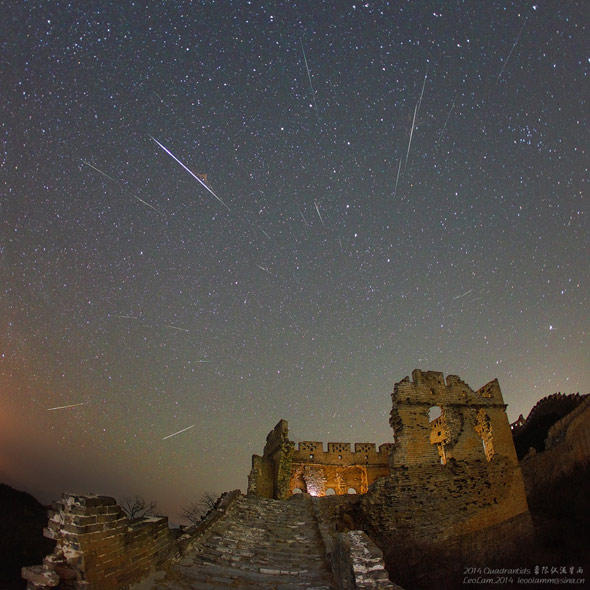Create a free profile to get unlimited access to exclusive videos, sweepstakes, and more!
Can You Catch the Quadrantids?

As the Earth orbits the Sun, it plows through a lot of debris. More than 100 tons of material burn up in our atmosphere every day on average; random bits of stuff dispersed over time from comets and asteroids.
Sometimes, though, our planet moves through the debris trail of a comet, tiny grains of rocks and dust sloughed off by previous passages of the comet as it, too, orbits the Sun. When that happens, we get a meteor shower. Because these happen when the Earth is at a certain point in its orbit, a given shower happens at roughly the same time every year.
The first major shower of the calendar year is the Quadrantids. It’s a weird one, for a lot of reasons (bear with me here). It gathers strength relatively slowly at first, with some meteors seen in late December. But then on top of that there’s a sharp peak just a few hours long that occurs a few days after the new year, with as many as 120 meteors per hour (though usually reported numbers are about half that).
This year, the shower peaks on Sunday night. Your best bet is to go outside after midnight (in other words, Sunday evening/Monday morning). The Moon will be a waning crescent, so it shouldn’t wash out too many meteors even though it rises around 01:00 local time. It doesn’t matter what direction you face, but the meteors will appear to stream away from a point on the sky to the northeast.
I’ve written about how to watch meteor showers many times. I suggest you read what I wrote about last month’s Geminids for generic instructions but replace the specifics (date/time/location) with what I have here for the Quadrantids.
As I said, the real peak is only hours long and is predicted for about 08:00 UTC (03:00 Eastern U.S. time). However, if you want to see them, I urge you to go out earlier than that in case the predictions are off. Because the peak is sharp, people in the U.S. are favored for seeing the best show. I encourage people at all longitudes to take a look, though. But not necessarily all latitudes; the Northern Hemisphere is strongly favored over the south.
Why? Well, it has to do with that weirdness I mentioned earlier.
Most meteor showers are from comets, but two are from asteroids: The December Geminids (from the asteroid 3200 Phaethon) and—you guessed it—the Quadrantids. The source of the meteoroid stream wasn’t known until quite recently, actually, until astronomer Peter Jenniskens published a paper that showed pretty convincingly that the asteroid 2003 EH1 was the parent body.
That rock is just a couple of kilometers in diameter and travels around the Sun on an orbit wildly tilted to that of Earth. Right now, it never really gets much closer to Earth than about 30 million kilometers. That’s a long way! So how can it produce a debris stream that crosses our orbit?
As Jenniskens points out, the orbit of the asteroid takes it relatively close to Jupiter. The giant planet’s gravity is mighty indeed, and over time it alters the shape of the asteroid’s orbit. Something like 500 years ago the asteroid was on an orbit that brought it much closer to Earth. Something happened around then to make it produce a debris trail. Since that time, the asteroid’s orbit has changed, and it now doesn’t get close to us. The same thing has happened to the stream of meteoroids, too, but they get dispersed; some scatter more than others. There are still enough of them intersecting Earth’s orbit that we get the annual Quadrantids … but over time that’ll change. Jupiter will not be ignored, and it will eventually, over centuries, fling the rubble away, and the Quadrantids will die off.
This, by the way, is why the Northern Hemisphere is favored for the meteor shower over the southern: Where the Earth crosses the asteroid's orbit, it's coming down from the north, from above the plane of Earth's orbit (using the standard "north is up" idea). We see the meteors coming from almost the north celestial pole, which means those of us with positive latitudes get the best view.
And here’s the last weird thing: What exactly caused 2003 EH1 to make a debris trail? 3200 Phaethon, the Geminids parent, gets really close to the Sun. It’s thought the heat from our star vaporizes the surface, making it release gravel. But EH1 doesn’t get any closer to the Sun than Earth does.
The most likely cause then is a collision with another asteroid. A smaller rock could’ve slammed into EH1, ejecting a cloud of material. That fits with what we see; a single stream of meteoroids dispersing over time (comets, as they orbit the Sun, episodically emit debris, so in some years we see stronger showers when we intersect those different streams). So it’s a coincidence that we happen to get a shower from such a recent collision. I’ll note that in the past few years we’ve seen several asteroid collisions, so they’re actually fairly common in space. This one just happened to occur near enough to Earth’s orbit that they get in our way, and we collide with them.
There is just nothing about this story that isn’t cool. An asteroid parent, a weird orbit, a changing weird orbit, Jupiter’s long gravitational reach, a collision in space, and then a lot of collisions as Earth plunges through the debris … and you can walk outside Sunday night after midnight, look up, and watch the aftermath for yourself!
This is some Universe we live in. I wouldn’t trade it for anything.


























